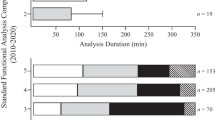Abstract
The present brief practice examined 6 randomly selected studies from the Journal of Applied Behavior Analysis that included functional analysis data replotted on the functional analysis celeration chart (FACC). The FACC showcases the practicality of a standard celeration chart– derived visual display. The research question asked, what level values occurred related to the original authors’ determination of function? Results indicated all functions had a ×2 level multiplier or higher when placed on the FACC.

Similar content being viewed by others
References
References marked with an asterisk indicate studies included in the review.
Austin, J. L., Groves, E. A., Reynish, L. C., & Francis, L. L. (2015). Validating trial-based functional analyses in mainstream primary school classrooms. Journal of Applied Behavior Analysis, 48, 274–288. https://doi.org/10.1002/jaba.208
Beavers, G. A., Iwata, B. A., & Lerman, D. C. (2013). Thirty years of research on the functional analysis of problem behavior. Journal of Applied Behavior Analysis, 46, 1–21. https://doi.org/10.1002/jaba.30.
Betz, A. M., & Fischer, W. W. (2011). Functional analysis history and methods. In W. W. Fisher, C. C. Piazza, & H. S. Roane (Eds.), Handbook of applied behavior analysis (pp. 206–225). New York, NY: Guilford Press.
CentralReach PrecisionX [Computer software]. (2019). Retrieved from https://centralreach.com/
Clark-Carter, D. (2005). Geometric mean. In B. Everitt & D. Howell (Eds.), Encyclopedia of statistics in behavioral science (pp. 744–745). Chichester, UK: John Wiley & Sons.
Diller, J. W., Barry, R. J., & Gelino, B. W. (2016). Visual analysis of data in a multielement design. Journal of Applied Behavior Analysis, 49, 980–985. https://doi.org/10.1002/jaba.325
*Falcomata, T. S., Wacker, D. P., Ringdahl, J. E., Vinquist, K., & Dutt, A. (2013). An evaluation of generalization of mands during functional communication training. Journal of Applied Behavior Analysis, 46, 444–454. https://doi.org/10.1002/jaba.37.
*Fisher, W. W., Greer, B. D., Fuhrman, A. M., & Querim, A. C. (2015). Using multiple schedules during functional communication training to promote rapid transfer of treatment effects. Journal of Applied Behavior Analysis, 48, 713–733. https://doi.org/10.1002/jaba.254.
*Gabor, A. M., Fritz, J. N., Roath, C. T., Rothe, B. R., & Gourley, D. A. (2016). Caregiver preference for reinforcement-based interventions for problem behavior maintained by positive reinforcement. Journal of Applied Behavior Analysis, 49, 215–227. https://doi.org/10.1002/jaba.286.
Gast, D. L., & Ledford, J. R. (2014). Single case methodology: Applications in special education and behavioral sciences. New York, NY: Routledge.
Hagopian, L. P., Fisher, W. W., Thompson, R. H., Owen-DeSchryver, J., Iwata, B. A., & Wacker, D. P. (1997). Toward the development of structured criteria for interpretation of functional analysis data. Journal of Applied Behavior Analysis, 30, 313–326.
Hagopian, L. P., Rooker, G. W., & Zarcone, J. R. (2015). Delineating subtypes of self-injurious behavior maintained by automatic reinforcement. Journal of Applied Behavior Analysis, 48, 523–543. https://doi.org/10.1002/jaba.236.
*Hammond, J. L., Iwata, B. A., Fritz, J. N., & Dempsey, C. M. (2011). Evaluation of fixed momentary DRO schedules under signaled and unsignaled arrangements. Journal of Applied Behavior Analysis, 44, 69–81. https://doi.org/10.1901/jaba.2011.44-69.
Iwata, B. A., & Dozier, C. L. (2008). Clinical Application of Functional Analysis Methodology. Behavior Analysis in Practice, 1, 3–9. https://doi.org/10.1007/BF03391714
Johnston, J. M., & Pennypacker, H. S. (2009). Strategies and tactics of behavioral research (3rd ed.). New York, NY: Routledge.
Kubina, R. M. (2019). The precision teaching implementation manual. Pittsburgh, PA: Greatness Achieved.
Marsteller, T. M., & St. Peter, C. C. (2014). Effects of fixed-time reinforcement schedules on resurgence of problem behavior. Journal of Applied Behavior Analysis, 47, 455–469. https://doi.org/10.1002/jaba.134.
Roane, H. S., Fisher, W. W., Kelley, M. E., Mevers, J. L., & Bouxsein, K. J. (2013). Using modified visual-inspection criteria to interpret functional analysis outcomes. Journal of Applied Behavior Analysis, 46, 130–146. https://doi.org/10.1002/jaba.13.
*Rodriguez, N. M., Thompson, R. H., Schlichenmeyer, K., & Stocco, C. S. (2012). Functional analysis and treatment of arranging and ordering by individuals with an autism spectrum disorder. Journal of Applied Behavior Analysis, 45, 1–22. https://doi.org/10.1901/jaba.2012.45-1.
Rohatgi, A. (2017). WebPlotDigitzer (Version 3.12) [Computer software]. Retrieved from. https://doi.org/10.1901/jaba.2010.43-745.
*Travis, R., & Sturmey, P. (2010). Functional analysis and treatment of the delusional statements of a man with multiple disabilities: A four-year follow up. Journal of Applied Behavior Analysis, 43, 745–749. https://doi.org/10.1901/jaba.2010.43-745.
Author information
Authors and Affiliations
Corresponding author
Ethics declarations
Conflict of Interest
The first author, Kubina, owns equity in CentralReach. The financial interest has been reviewed by the Pennsylvania State University’s Individual Conflict of Interest Committee and is currently being managed by the university. The second and third authors declare that they have no conflicts of interest.
Additional information
Publisher’s Note
Springer Nature remains neutral with regard to jurisdictional claims in published maps and institutional affiliations.
Research Highlights
• This study shows the potential to quantify the identification of function, thereby enhancing the ability of clinicians to better identify patterns of responding present in functional-analytic assessments.
• The FACC offers a standard display with the potential benefits of engendering uniformity and consistency in decision making thereby increasing the efficiency of data analysis.
• Adding the FACC to a clinician’s present approach to functional analysis does not require any additional changes aside from the visual graphic.
• This study ameliorates criticisms of subjectivity inherent in visual inspection alone by offering consistent interpretations of data with new metrics (i.e., level multiplier).
Rights and permissions
About this article
Cite this article
Kubina, R.M., Ruiz, S. & Kostewicz, D.E. Quantifying Function with the Functional Analysis Celeration Chart. Behav Analysis Practice 14, 728–733 (2021). https://doi.org/10.1007/s40617-020-00426-x
Published:
Issue Date:
DOI: https://doi.org/10.1007/s40617-020-00426-x




